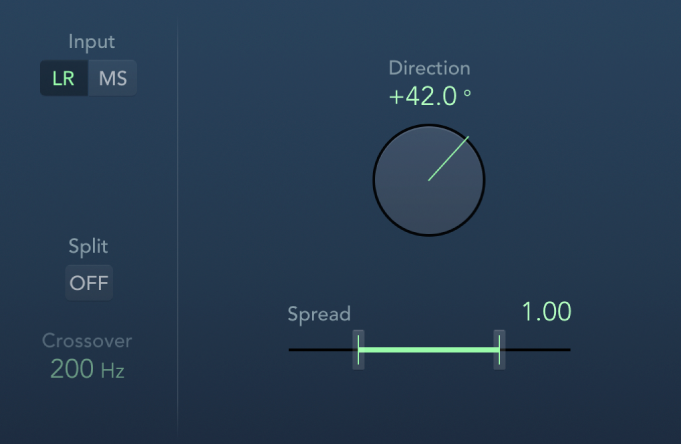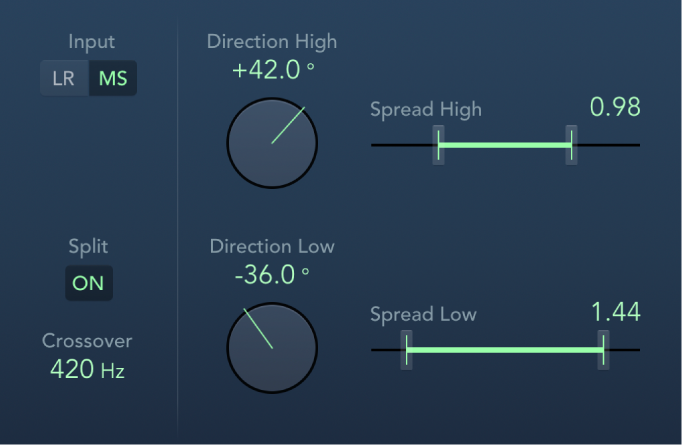Direction Mixer controls in Final Cut Pro for Mac
You can use Direction Mixer to decode middle and side audio recordings or to spread the stereo base of a left/right recording and determine its pan position.
Direction Mixer works with any type of stereo recording, regardless of the miking technique used. For information about the most common stereo miking techniques—AB, XY, and MS—see Stereo miking techniques in Final Cut Pro for Mac.

Input buttons: Set the input signal type. Use LR if the input signal is a standard left/right signal. Use MS if the signal is middle and side encoded.
Direction knob and field: Set the pan position for the middle—the center of the stereo base—of the recorded stereo signal. When Direction is set to a value of 0, the midpoint of the stereo base in a stereo recording is perfectly centered within the mix.
When you work with LR signals:
At 90°, the center of the stereo base is panned hard left.
At −90°, the center of the stereo base is panned hard right.
Higher values move the center of the stereo base back toward the center of the stereo mix, but this also has the effect of swapping the stereo sides of the recording. For example, at a value of either 180° or −180°, the center of the stereo base is dead center in the mix, but the left and right sides of the recording are swapped.
When you work with MS signals:
At 90°, the middle signal is panned hard left.
At −90°, the middle signal is panned hard right.
Higher values move the middle signal back toward the center of the stereo mix, but this also has the effect of swapping the side signals of the recording. For example, at a value of either 180° or −180°, the middle signal is dead center in the mix, but the left and right sides of the side signal are swapped.
Spread slider and field: Determine the spread of the stereo base in LR input signals, or set the side signal level in MS input signals. Spread parameter behavior changes when fed LR or MS signals. These differences are outlined below.
When you work with LR signals:
At a neutral value of 1, the left side of the signal is positioned precisely to the left and the right side precisely to the right. As you decrease the Spread value, the two sides move toward the center of the stereo image.
A value of 0 produces a summed mono signal—both sides of the input signal are routed to the two outputs at the same level. At values greater than 1, the stereo base is extended out to an imaginary point beyond the spatial limits of the speakers.
When you work with MS signals:
Values of 1 or higher increase the level of the side signal, making it louder than the middle signal.
At a value of 2, you hear only the side signal.
Split button: Split the signal into independently controlled high and low ranges.
Crossover field: Set the frequency where the signal is split between high and low ranges. Drag vertically, or double-click and type a value.

Direction High and Direction Low knobs and fields: Independently set the central pan position for the recorded stereo signal in the upper or lower frequency range (set with Crossover).
Spread High and Spread Low sliders and fields: Independently set the stereo spread in LR signals, or set the side signal level in MS signals for the upper/lower frequency range (set with Crossover).
Download this guide: PDF